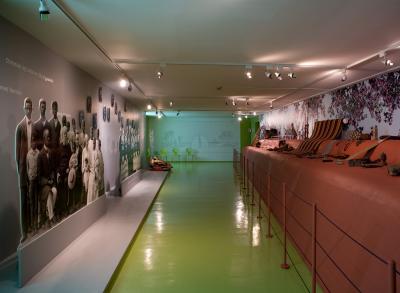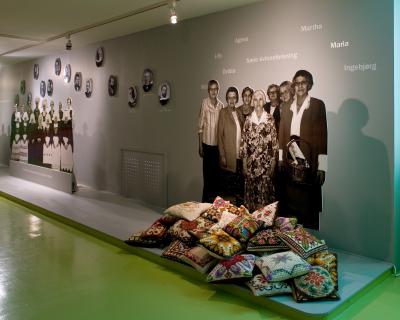Photographs as performing actors
The exhibition called I Permit myself to Send You a Bundle of Malagasy Things at the University Museum of Bergen, which I curated, is based on the museum’s Madagascar-collection. The rectangular exhibition space has a dual structure: Along one of the long walls, ethnographic objects are placed on a base painted in strong, red earth colours. The wall behind this base is covered by a photographic wallpaper of jacaranda flowers. The objects on display on the ‘earthly’ base are grouped into classic ethnographic typologies: musical instruments, weapons, magical and ritual objects, textiles and objects of everyday life, such as kitchen utensils and tools. As a totality, this installation takes the shape of an imaginary landscape.
While this first wall has ethnographic objects as its central focus, the opposite long wall has photographs. A series of portraits covers the upper part of this second wall, representing persons connected to the Madagascar-collection: a museum director, missionary collectors and donators, characters which are relevant in relation to the earliest part of the collection’s history. The persons are named, and for citizens of Bergen, it becomes obvious that many of them belong to the wealthy local bourgeoisie. Exhibition and catalogue texts also connect the donators to the Christian mission movement. Detached, but still related to the wall are three other photographs; all group portraits in natural-size cut silhouettes. The first group shows a missionary couple surrounded by their adopted Malagasy family and a Norwegian missionary friend. The photograph is taken in 1912. The next group portrait taken in the early 1930s, represents a group of women in Norwegian national costumes. The group is more specifically members of a women’s mission association who worked to promote and raise money to the mission cause. The third and final group image also portrays the members of a women’s mission association, but this time the image is contemporary - of a group still active in this work. A pile of embroidered pillows is placed at the women’s feet – something which forms a concrete reminder of these women’s engagement in mission associations’ activities. All portraits are placed so that the depicted people have their faces turned towards, and thus appear to be looking at, the objects on display on the opposite wall.
The end wall is covered by ‘wallpaper’ showing a graphic reproduction of a well-known missionary motif titled “come and help us”. This envisages one of the master narratives of the mission movement: the vision of the heathen people calling for the same form of salvation as the Christians. The image is a representation of an African family on their natives shores, waving towards a sail ship depicted in silhouette in front of a warm, rising sun. The relatively narrow stripe of floor between the long walls, is painted strikingly green - the colour of freshly germinating rice. A sound installation is heard vaguely in the background – a composition which makes use of elements of Christian hymns as well as Malagasy folk music.
In this exhibition the role of the photographs is extended from that of mere illustration or contextualisation. Instead they work as the centre of a staged performance, and thus at the centre of the story told (or the narrative of the exhibition). While the exhibition focused on the Madagascar collection’s history, and in particular its connection to missionary activities and the relationship between the museum and the Christian mission movement, it also stages a particular way of looking at the ‘other’ in a very tangible manner. The photographs contribute both to visualise and problematise the ‘colonial gaze’. In this way colonial photographs are used in a (self-)critical way. The main message is simple: the image of Madagascar produced by the Madagascar-collection is shaped by its collectors, museum practices, and spectators. This is emphasised by the way visitors when looking at the objects, are directed to imitate the position of those depicted in the photographs; those who once were responsible for the collection, and thus are co-responsible for producing a particular world view. While the photographs and the visitors in this position mirror each other, the small group of chairs along the short wall encourages the visitors to make an overview of the scene. The photographs work as performance actors, but they also contribute to historicise the exhibition, simply by showing that the objects (and the museum) have a history.
Hilde Nielssen

